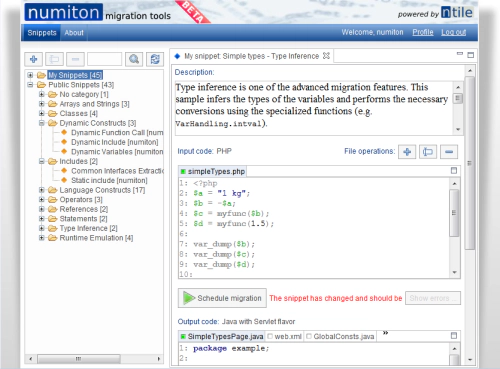RAP Case Study: Numiton Migration Tools
I always want to hear why people pick the Eclipse Rich Ajax Platform (RAP) and what applications they are building with it. Last week I send a few questions to Robert Enyedi, CEO at Numiton.com, to find out how they use RAP.

(click picture to view demo)
Elias: What does your application do?
Robert: We are in the business of automated software migration and we wanted to show a bit of what we do. Any visitor can use this tool to browse migration samples shared by others. Registered users can also create their own snippets and share them if they choose to. We currently support the PHP language as input and produce Java code using the Spring framework or just plain servlets. In the future we plan to extend support to other input and output languages from our development pipeline.
Elias: Why did you choose Eclipse RAP?
Robert: The migration system is written in Java on top the the Eclipse RCP framework. So we needed a UI technology that interoperates well with Java.
Also, it had to be a Web application and not a regular site. Rich user experience was a must which brought AJAX-based technologies into focus. We are Java junkies, but an applet or Java Web Start application were out of the question: we couldn’t justify the need for a client-side JRE and its slow startup time for such a relatively simple application. Yes, since JRE 1.6.0 update 10 things improved, but how many users have that version installed?
Having previous experience with the Google Web Toolkit (GWT), that was our next choice. However, as we laid out the features we wanted, we started to see that it will take a lot of effort to implement them in GWT. We wanted readily available functionality like wizards, message dialogs, dockable views and so on. When evaluating RAP we found all these and much more. We quickly rebuilt the prototype with RAP and SWTDesigner and never looked back.
Elias: How did RAP work out in your project?
Robert: We had a fast development time and we found no technical problems that we couldn’t overcome. It is fair to point out though that we have extensive Eclipse RCP experience from building our migration system and not only.
I want to emphasize that personally I am very pleased about the code quality we managed to maintain, even in the final phases of development. Compared to traditional Web applications, developing on the RAP platform makes it easy to produce well organized code. GUI design tools that work with SWT usually work with RWT as well - so designing the perspectives, views, dialogs and composites is very easy.
From the feedback that we have gathered so far, the users love the application and the overall usability is very good. They also appreciate the coolness factor, even if this is a really simple front-end.
Overall we look forward to the e4 platform for which RAP should provide the Web runtime and we strongly believe that even now RAP is the best technology for developing enterprise-grade Web applications.
Elias: Robert, thanks for the interview.
Would you like to share your own RAP story? Email us!